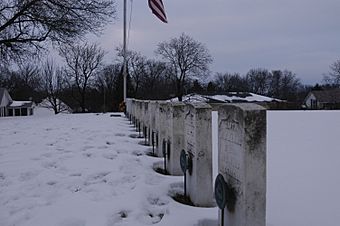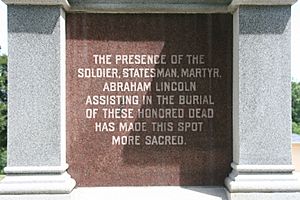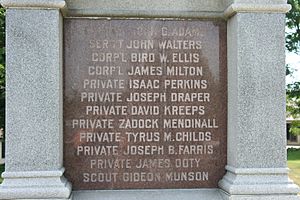Stillman's Run Battle Site facts for kids
Quick facts for kids |
|
|
Stillman's Run Battle Site
|
|

The tombstones of the fallen are part of the memorial at the site of the Battle of Stillman's Run.
|
|
| Location | Roosevelt and Spruce Sts., Stillman Valley, Illinois |
|---|---|
| Area | less than one acre |
| Built | 1901 |
| Architect | Creo and Creo, J. H. Anderson |
| NRHP reference No. | 83003587 |
| Added to NRHP | December 8, 1983 |
The Stillman's Run Battle Site is an important historical place in Stillman Valley, Illinois. It is recognized on the National Register of Historic Places, which means it's a special spot worth preserving. This site marks where the Battle of Stillman's Run happened in 1832. This battle was a fight between the Illinois militia and Black Hawk and his group of Sauk warriors.
The battle was part of a bigger conflict called the Black Hawk War. During the fight, 12 militia soldiers died while bravely defending a small hill. The rest of the militia ran back to Dixon's Ferry. There, they spread the word about a terrible defeat at Stillman's Run.
Contents
What Happened at Stillman's Run?
The Battle of Stillman's Run took place on May 14, 1832. It got its name from Major Isaiah Stillman. He led about 275 Illinois militia soldiers. These soldiers quickly ran away from a large group of Sauk warriors. Some people who saw the battle said the militia might have been outnumbered two to one.
This fight was the very first battle of the 1832 Black Hawk War. The war began after Black Hawk crossed the Mississippi River into Illinois. He was with his "British Band" of Sauk and Fox people. As mentioned, 12 militia soldiers were killed. They made a brave stand on a small hill. The other soldiers fled back to Dixon's Ferry. They told everyone about a big loss at Stillman's Run. We don't know exactly how many Sauk and Fox warriors were killed. Black Hawk himself said at least three, and maybe up to five, of his warriors died.
The Stillman's Run Monument
Today, a monument made of marble and granite stands at the site of the Battle of Stillman's Run. It was designed and built by Creo and Creo, along with J.H. Anderson. The Battlefield Memorial Association of Stillman Valley put up the monument in 1901. Funds for it came from the state of Illinois. These funds were approved during the 42nd General Assembly. The monument site is less than one acre. It is now a small park where people can visit.
The shiny marble monument has several messages carved into it. One side of the monument says:
In memory of the Illinois volunteers who fell at Stillman's Run, May 14, 1832, in an engagement with Black Hawk and his warriors."
Another message on the monument reads:
The presence of soldier, statesman, martyr, Abraham Lincoln assisting in the burial of these honored dead has made this spot more sacred."
A historical marker at the site also states:
Here, on May 14, 1832, the first engagement of the Black Hawk War took place. When 275 Illinois militiamen under Maj. Isaiah Stillman were put to flight by Black Hawk and his warriers. So thoroughly demoralized were the volunteers that a new army had to be called into the field."
Another carving on the monument explains that the Battlefield Memorial Association of Stillman Valley built it. It also notes that the money came from the Illinois General Assembly and was approved on May 1, 1901. There is also a list of the soldiers who died carved onto the monument.
Remembering Those Who Fell
The monument lists the names of the U.S. Militia soldiers who died during the battle. These brave individuals are remembered for their sacrifice.
| Listed casualties from monument (US Militia) |
|---|
| Captain John Giles Adams |
| Sergt John Walters |
| Corp'l Bird W. Ellis |
| Corp'l James Milton |
| Private Isaac Perkins |
| Private Joseph Draper |
| Private David Kreeps |
| Private Zadock Mendinall |
| Private Tyrus M. Childs |
| Private Joseph B. Farris |
| Private James Doty |
| Scout Gideon Munson |
Why This Site Is Important
The Stillman's Run Battle Site was added to the National Register of Historic Places on December 8, 1983. It was recognized for its important role in military history. This site helps us remember a key event from the Black Hawk War.





